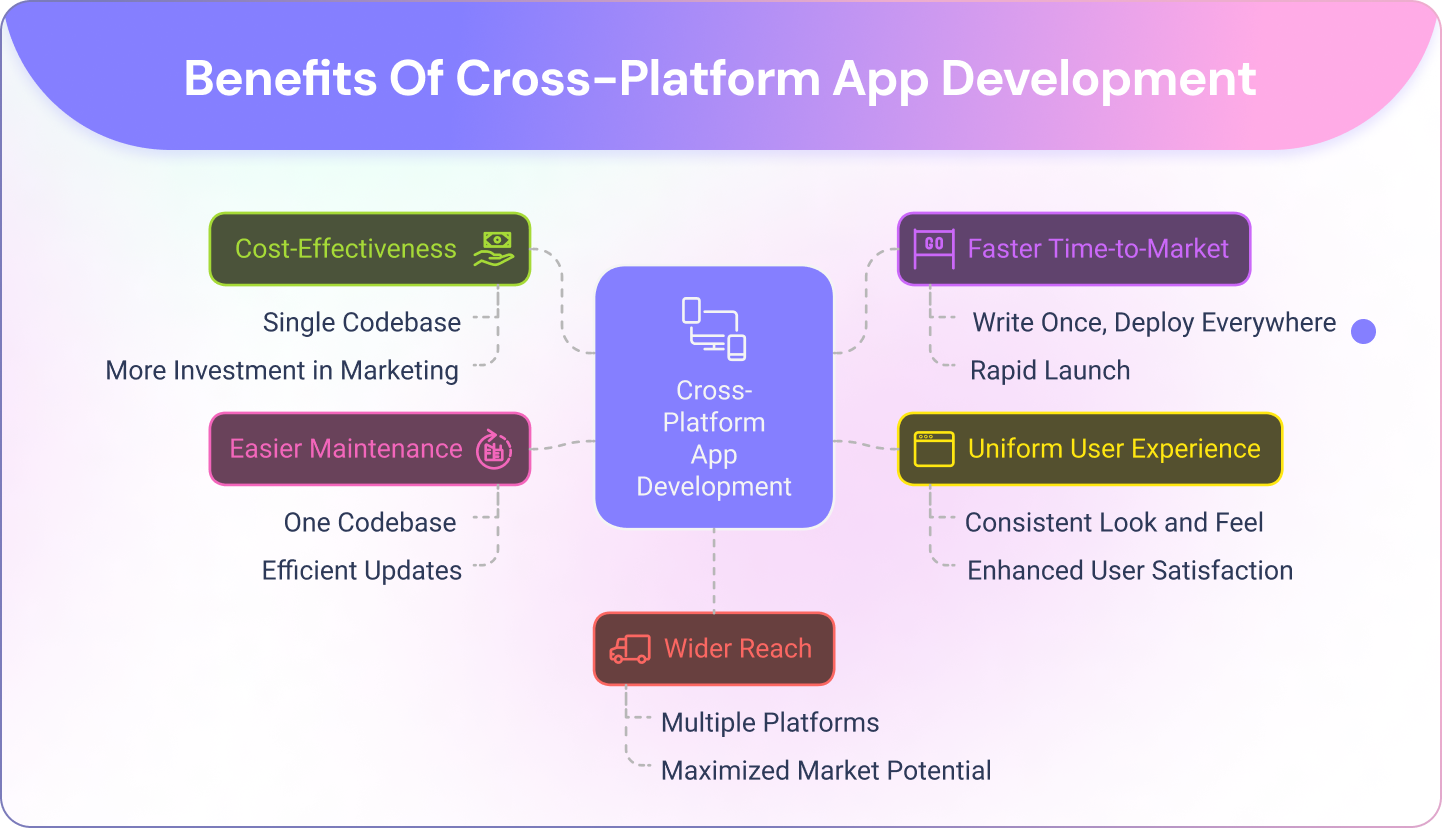Cross-Platform App Development: What It Is and How It Works
In the fast-paced world of technology, businesses are always on the lookout for efficient and cost-effective ways to reach their audiences. One of the most groundbreaking developments in recent years is cross-platform app development, which has become a cornerstone for enterprises looking to establish a digital presence.
This article delves into what cross-platform app development is, how it works, and why it’s a game-changer in the realm of Android application development services.
What is Cross-Platform App Development?
Cross-platform app development describes the process of developing a software application that is natively compatible with multiple OS, such as iOS, Android, and Windows, while using a single code base. Unlike native development-that requires separate code bases on each platform-cross-platform allows developers to write code just once and deploy it everywhere. This approach not only saves time but also cost significantly.
The secret to cross-platform app development is in the frameworks used. A cross-platform app development framework equips developers with tools, libraries, and APIs to design applications that work seamlessly across multiple platforms. These ensure consistency in performance, user experience, and functionality. That’s why businesses tend to favor them.
How Does Cross-Platform App Development Work?
The “write once, run anywhere” philosophy forms the basis of cross-platform app development. Developers make use of specialized frameworks that translate a single codebase into native code for various operating systems.
This process includes:
Choosing a Framework: The first step in cross-platform application development is to choose the right framework. Popular choices include React Native, Flutter, Xamarin, and Ionic. Each framework has its strengths and is suitable for different types of projects.
Writing the Codebase: Developers write the logic and interface of an application using languages supported by a chosen framework, such as JavaScript for React Native or Dart for Flutter.
Compilation of Code: The single codebase is compiled by a framework into native code particular to each platform. For example, Flutter compiles into native ARM code on both iOS and Android.
Testing and Debugging: Developers utilize the integrated testing tools that the framework offers to find and correct bugs. This step ensures that the app is consistent across all platforms.
Deployment: After testing, the app is deployed to app stores or distribution channels for users to download and use.
Benefits of Cross-Platform App Development
Cross-platform application development offers a number of benefits that make it a popular choice for businesses and developers:

Cost-Effectiveness: With a single codebase, development costs are significantly lower than native development. Businesses can invest more in other aspects, such as marketing and user acquisition.
Faster Time-to-Market: Writing code once and deploying it across platforms accelerates the development process, allowing businesses to launch their apps quickly.
Uniform User Experience: Cross-platform frameworks ensure a consistent look and feel across all devices, enhancing the user experience.
Easier Maintenance: The update and maintenance of one codebase are easier and more efficient than multiple codebases.
Wider Reach: Businesses can reach a greater audience by catering to several platforms at the same time, maximizing their market potential.
Popular Cross-Platform App Development Frameworks
Choosing the right framework makes all the difference for the success of your project. Here are some of the most widely used cross-platform app development frameworks:
React Native: Developed by Facebook, React Native is one of the most popular frameworks. It uses JavaScript and provides near-native performance, making it ideal for Android application development services.
Xamarin: It is a Microsoft product that uses C# and.NET. Using this, developers can share up to 90% of the code across platforms.
Ionic: Based on Angular and Apache Cordova, Ionic is perfect for developing hybrid mobile applications using a web-based approach.
Unity: Mainly used for game development, Unity is a powerful tool that allows developers to create interactive and engaging experiences for multiple platforms.
Flutter: Flutter is developed by Google, which uses the Dart programming language and offers a rich set of widgets for the creation of visually appealing and high-performance apps.
Cross-Platform vs. Native Development
While cross-platform development has numerous advantages, it is also essential to understand how it differs from native development:
Performance: Native apps are optimized for a specific platform and are better in performance. However, frameworks like Flutter and React Native have bridged the gap and deliver nearly native performance.
Development Time: Cross-platform development is faster because developers write code once. Native development involves separate codebases, increasing the time and effort.
Cost: Cross-platform development is less expensive and therefore can be used by start-ups or companies that are running low on budget.
Flexibility: Native development provides a direct access to device-specific features, which might not be possible with cross-platform frameworks in certain scenarios.
Role of Android Application Development Services
Cross-platform application development success largely depends on Android application development services. These services take advantage of cross-platform frameworks to design apps that will serve the purpose of Android users while keeping them compatible with other applications. Companies offering Android application development services are known for:
: Analyzing business needs to decide which framework will be best for the given business needs.
: Designing user-friendly interfaces that function across platforms without issues.
Implementation of effective testing to maintain consistency across devices running on the Android OS.
Real-World Applications of Cross-Platform App Development
Many well-known companies have adopted cross-platform app development to deliver high-quality user experiences. Examples include:
Instagram: Uses React Native to manage its large user base and provide consistent performance.
Google Ads: Built with Flutter, this app showcases the framework’s ability to handle complex functionalities.
Skype: Developed using Xamarin, Skype offers a consistent experience across platforms.
Challenges in Cross-Platform App Development
Despite its advantages, cross-platform application development has some challenges:
Performance Limitations: Although frameworks aim to match native performance, some applications may still have minor lags.
Limited Access to Platform-Specific Features: Certain features may not be completely supported by all frameworks, and hence additional workarounds are needed.
Framework Updates: Developers need to keep themselves updated with changes in the framework to avoid compatibility issues.
The Future of Cross-Platform App Development
Cross-platform app development is sure to become more sophisticated as technology continues to evolve. There is continuous improvement of the framework to meet the already present challenges and offer greater functionality. Advancements in tools and technologies will surely enhance efficiency and performance in the business world.
Conclusion
Cross-platform app development framework has transformed the way businesses create and deliver applications. Powerful frameworks can be used to develop apps that can reach diverse audiences while saving time and costs. Investing in cross-platform application development and Android application development services is a strategic move for businesses looking to make an impact in the digital world.
In a nutshell, cross-platform app development is the flexible and efficient solution that business ventures can use to have a solid digital presence. It is possible to make applications with the right framework and expertise that deliver great user experiences, which explains why this approach is the backbone in the tech industry today.
TABLE OF CONTENT
- What is Cross-Platform App Development?
- How Does Cross-Platform App Development Work?
- Benefits of Cross-Platform App Development
- Popular Cross-Platform App Development Frameworks
- Cross-Platform vs. Native Development
- Role of Android Application Development Services
- Real-World Applications of Cross-Platform App Development
- Challenges in Cross-Platform App Development
- The Future of Cross-Platform App Development
- Conclusion
